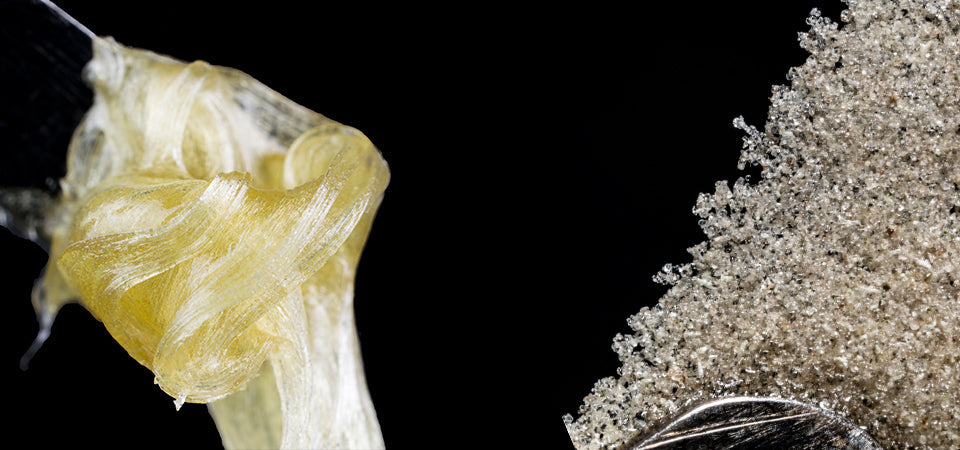Comparing Bubble Hash vs Rosin as Solventless Extracts

Bubble hash and rosin are two products that can be made from cannabis plant material using mechanical (solventless) techniques. However, owing to the differences in the extraction process, the finished products have different textures, potencies, and commercial applications.
If you're looking to produce solventless extracts commercially or experiment with solventless extraction at home, understanding the differences and similarities between bubble hash and rosin can help you get the best out of each of these fabulous products.
Extraction Method
Both bubble hash and rosin are made using mechanical extraction processes that don't involve the introduction of solvents like butane, propane, ethanol, or supercritical CO2. However, whereas bubble hash is made using cold water and gravity, rosin is made using pressure and heat.
This fundamental difference means a difference in processing equipment—you can make bubble hash with equipment that's as simple as a bucket and a hand paddle (although you'll need professional hash washing equipment to produce bubble hash commercially), whereas special equipment with pressurized cylinders and heated plates is required for pressing rosin.
Ice Water Extraction Process

To make bubble hash or “ice water hash,” cannabis buds or trim (fresh frozen, frozen, or dried and cured) are submerged in ice water and agitated using a mechanical agitator or hand paddle until the trichome heads separate from the plant material and fall to the bottom of the vessel. From there, the fallen trichomes are filtered through micron-rated "bubble bags," starting with a 220µm bag and finishing with a 45µm or 25µm bag to capture the largest, highest-quality trichome heads.
The result of the bubble hash making process—depending on the size of the micron heads—is pure or near-pure hash. After filtration, the bubble hash is dried in a freeze dryer to remove the moisture, leaving a light-brown concentrate with a grainy or sandy texture.
Rosin Extraction Process
Rosin is a little different from bubble hash in that there are several substances you can use for your starting material. In contrast, you'll always use cannabis buds or trim when making bubble hash.
To make rosin, you place bubble hash, dry sift hash, kief, or cannabis flowers in a rosin bag, fold the bag inside parchment paper, and press this “packet” between the heated plates of a rosin press. After a few seconds to a minute, the walls of the trichome heads will rupture and the sticky resin inside will flow out onto the parchment paper for collection. Check out our How to Make Rosin guide for a detailed step-by-step explanation.
Purity, Potency, Color, and Flavor
The purity, potency, color, and flavor of either bubble hash or rosin depend on the quality and freshness of the starting material and the type of extraction equipment you use.

- Purity. Both bubble hash and rosin have the potential to be very pure extracts, with minimal if any plant matter. Achieving the highest possible purity and quality generally depends on the size of the trichome heads on the original plant material, the quality and precision of the extraction equipment used, and the extractor’s skill level.
- Potency. Both extracts can contain upwards of 60% THC, which is much higher than the THC content of whole flower. However, only rosin can reach percentages of 80% THC, and occasionally higher, because it's a more highly refined extract.
- Color. Bubble hash is generally beach-sand blonde or very light in color (depending on the maturity of the trichomes), whereas rosin can come out translucent, golden, or amber—depending on the starting material. Flower rosin (rosin pressed directly from dried-and-cured cannabis flowers) is generally darker than bubble hash rosin or rosin pressed from dry sift hash. However, you can still achieve a golden yellow color with the right starting material and equipment.
- Flavor. Both rosin and bubble hash have a full-bodied flavor, especially if you start with fresh frozen cannabis that still has the original terpene profile intact. However, rosin usually has a cleaner flavor than ice water hash due to the removal of the trichome husks.
A note about melt: Bubble hash and dry sift are graded on the level of "melt" achieved when the extract is dabbed. These grades range from cooking grade (1 or 2 stars) to half melt (3 or 4 stars) and ultimately full melt (6 stars), which means that it melts completely when dabbed. Rosin isn’t graded on melt, as—by definition—it’s a pure extract that should vaporize completely when dabbed.
Consistency

Rosin is far more versatile than bubble hash when it comes to the kinds of consistencies and textures you can create. Whereas bubble hash has a grainy consistency as long as it’s kept frozen (at room temperature, it will melt partially and become tacky), rosin can be manipulated into several different consistencies:
- Budder/badder
- Sap
- Shatter
- Jam
- Sauce (or sauce and diamonds)
To create these consistencies, the extractor will choose strains with specific terpene profiles, use specific temperature ranges for pressing and then for the curing process, and may also use other post-processing techniques like whipping. The higher the concentration of terpenes in the starting material, the lower the viscosity of the resulting rosin.
Commercial Possibilities

Both rosin and bubble hash can be sold commercially as they are (for dabbing or vaping) or can be processed further to create a wide range of SKUs.
Rosin can be used to make:
- Vape carts
- Edibles
- Topicals
- Infused pre-rolls
Bubble hash can be used to make:
- Hand-pressed hash consumables
- Hash joints
- Infused joints
- Hash rosin
As far as marketability, there are great opportunities for both kinds of concentrates in the cannabis industry. In 2022, the cannabis concentrate market was estimated to be worth $1.9 billion with an anticipated 6.20% CAGR through 2030. Moreover, solventless extracts are in high demand with medical and health-conscious consumers who want a clean, high-quality experience.
Hash Rosin: The Ultimate Solventless Extract
We've considered the bubble hash vs rosin question at some length, but you can ultimately have the best of both worlds with solventless “hash rosin"—rosin pressed from bubble hash. For the most premium extract—live hash rosin—freeze your freshly harvested cannabis buds, wash the buds in a professional hash washing machine, dry the ice water hash in a professional freeze dryer, and press the hash at low temperatures (140 to 180 °F) in a rosin press.
For hash rosin, you'll use smaller micron rosin bags than you would for flower rosin. We also recommend double-bagging your ice water hash for pressing to prevent blowouts. For best results when making hash rosin, look for starting material that's rich in trichomes and has trichome heads in the range of 72µm to 120µm with a capitate-stalked or glandular-domed shape.
Rosin, Bubble Hash, and Hash Rosin - A World to Explore
Hopefully, we've resolved your questions about rosin vs hash (specifically, bubble hash) and demonstrated the strengths and unique capabilities of each. While both separations are achieved mechanically rather than using chemical solvents, bubble hash is a simpler and less refined extract than rosin, isn't quite as potent, and has a simpler, tackier consistency.
If you have the right equipment, making hash rosin offers a best-of-both-worlds solution that fetches top prices in dispensaries. And if you start with fresh frozen cannabis and maintain the cold chain from harvest to shelf, you can create solventless extracts that are clean, potent, flavorful, and have an excellent ROI.



